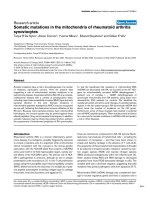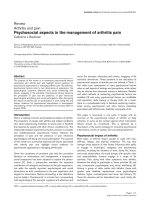Báo cáo y học: "Critical care in the 21st century: preparation, preparation, and preparation" docx
Bạn đang xem bản rút gọn của tài liệu. Xem và tải ngay bản đầy đủ của tài liệu tại đây (27.13 KB, 2 trang )
3
ICU = intensive care unit.
Available online />This month in Critical Care we are launching a disaster
management themed section, and we hope that the series of
articles published in this section will be an important
education tool for all of our readers.
Recent history has made us much more aware of disasters,
be they natural, accidental, or terrorist driven, and our need
to prepare for them has never been greater. The first article in
this series, by Turégano-Fuentes and coworkers [1] from the
Gregorio Marañón University General Hospital in Madrid,
Spain, covers the terrorist bombing that occurred in Madrid
in March this year, and is accompanied by a related
commentary by Frykburg [2].
Dr Turégano-Fuentes is Chief of General Surgery and the
Emergency Department at the Gregoreo Marañón University
General Hospital. Turégano-Fuentes and his co-authors,
encompassing the fields of neurology, general surgery and
intensive care, have combined their experience and expertise
to produce a report that covers the logistics, injuries and
clinical management of the casualties seen in their hospital
after the Madrid bombings, from emergency room to
intensive care unit (ICU). We must acknowledge the strength
and courage of all those involved in dealing with this event,
but we must also learn from them, and it is our hope that this
article will help us to do so.
The article provides several important lessons in dealing with
a mass casualty situation. It also raises questions that should
be considered in the development and implementation of
trauma strategies in health care institutions worldwide, such
as how does one balance over-triage and under-triage in the
hospitals closest to the blast, and just how does one prepare
staff for these situations [1,2]?
Since 9/11 it has been observed that situations resulting in
mass injury tend to possess certain similarities with regard to
the treatment of patients, and it is generally agreed that
better preparation is needed [3–5]. As well as preparations
for dealing with the patients from a logistical and medical
viewpoint, we must take into consideration critical incident
stress management, not only for the victims but also for the
workers involved from across emergency services. One of
the most difficult aspects faced by the emergency services is
the exposure to sudden, violent death across all age groups
[6]. The matter of leadership and team collaboration in the
ICU are also important. A recent report by Lingard and
colleagues [7] addressed the ‘rules’ and dynamics of
collaboration in ICU teams. Their paper stressed the need to
move beyond the rhetoric of cooperation and toward a more
grounded understanding of how an ICU team works in daily
practice, which could then be utilized in disasters and other
crisis situations.
In the coming months we shall commission further articles
covering all aspects of disaster management, including
SARS, the role of critical care in complex medical operations,
educational programmes for intensivists, communication,
leadership and victim support, as well as further first-hand
experiences in mass casualty situations.
Editorial
Critical care in the 21st century: preparation, preparation, and
preparation
Charlotte England
1
, Kerrie Lapworth
2
, Emdadur Rahman
3
and Jean-Louis Vincent
4
1
Senior editorial assistant, F1000 Medicine, Editorial office, BioMed Central Ltd, London, UK
2
In-house Editor, Critical Care, Editorial office, BioMed Central Ltd, London, UK
3
Assistant Editor, Critical Care, Editorial office, BioMed Central Ltd, London, UK
4
Editor-in-Chief, Critical Care, and Head, Department of Intensive Care, Erasme Hospital, University of Brussels, Belgium
Correspondence: Critical Care Editorial Office,
Published online: 18 November 2004 Critical Care 2005, 9:3-4 (DOI 10.1186/cc3008)
This article is online at />© 2004 BioMed Central Ltd
4
Critical Care February 2005 Vol 9 No 1 England et al.
Competing interests
CE, ER and KL are employees of BioMed Central and
receive a fixed salary. As editor-in-chief, JLV receives a fixed
honorarium from Current Science Ltd, which is part of
BioMed Central
References
1. Peral Gutierrez de Ceballos J, Turégano-Fuentes F, Perez-Diaz D,
Sanz-Sanchez M, Martin-Llorente C, Guerrero-Sanz JE: 11 March
2004: The terrorist bomb explosions in Madrid, Spain – an
analysis of the logistics, injuries sustained and clinical man-
agement of casualties treated at the closest hospital. Crit
Care 2005, 9:in press.
2. Frykberg ER: Terrorist bombings in Madrid. Crit Care 2005, 9:in
press.
3. Martinez C, Gonzalez D: The World Trade Center attack:
doctors in the fire and police services. Crit Care 2001, 5:304-
306.
4. Mattox K: The World Trade Center attack disaster prepared-
ness: health care is ready, but is bureaucracy? Crit Care 2001,
5:323-325.
5. Crippen D: The World Trade Center attack: Similarities to the
1988 earthquake in Armenia: time to teach the public life-sup-
porting first-aid? Crit Care 2001, 5:312-314.
6. Hammond J, Brooks J: The World Trade Center attack: helping
the helpers: the role of critical incident management. Crit Care
2001, 5:315-317.
7. Lingard L, Espin S, Evans C, Hawryluck L: The rules of the
game: interprofessional collaboration on the intensive care
unit team. Crit Care 2004, 8:R403-R408.









